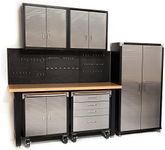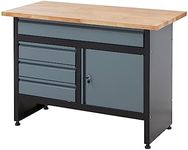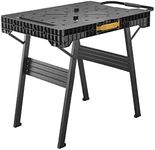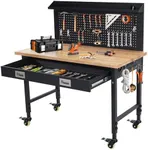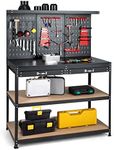Buying Guide for the Best Workbenches
Choosing the right workbench is crucial for creating an efficient and comfortable workspace, whether you're a professional craftsman, a hobbyist, or someone who needs a sturdy surface for various tasks. The right workbench can enhance productivity, provide adequate storage, and ensure safety during work. When selecting a workbench, consider the type of work you'll be doing, the space available, and any specific features that might be beneficial for your tasks.SizeThe size of a workbench is important because it determines how much workspace you have and how well it fits into your designated area. Workbenches come in various sizes, from compact models suitable for small spaces to large ones that offer extensive surface area for bigger projects. If you have limited space, a smaller workbench might be ideal, but ensure it still provides enough room for your tasks. For larger projects or if you have ample space, a bigger workbench can offer more flexibility and comfort.
MaterialThe material of a workbench affects its durability, weight, and suitability for different tasks. Common materials include wood, metal, and plastic. Wooden workbenches are often preferred for their sturdiness and traditional look, making them ideal for woodworking. Metal workbenches are durable and can handle heavy-duty tasks, while plastic workbenches are lightweight and resistant to chemicals, suitable for lighter tasks or environments where corrosion is a concern. Choose a material that aligns with the type of work you do and the conditions of your workspace.
HeightThe height of a workbench is crucial for comfort and ergonomics. A workbench that is too high or too low can lead to discomfort and strain during prolonged use. Adjustable-height workbenches offer flexibility and can be tailored to your specific needs, making them ideal for shared spaces or varied tasks. If you primarily work standing, ensure the height allows you to work comfortably without bending over. For seated tasks, the workbench should be at a height that allows you to sit comfortably with your feet flat on the ground.
Storage OptionsStorage options in a workbench can greatly enhance organization and efficiency. Workbenches may come with drawers, shelves, or pegboards for storing tools and materials. If you have a lot of tools or materials, a workbench with ample storage can help keep your workspace tidy and ensure everything is easily accessible. Consider the types of items you need to store and choose a workbench with storage solutions that meet your needs, whether it's for small tools, large equipment, or materials.
Weight CapacityWeight capacity refers to the maximum load a workbench can support. This is important for ensuring safety and stability, especially if you plan to work with heavy materials or equipment. Workbenches with higher weight capacities are suitable for heavy-duty tasks, while those with lower capacities are better for lighter work. Assess the weight of the items you typically work with and choose a workbench that can safely support them without risk of damage or collapse.
MobilityMobility is a feature that allows you to move your workbench easily within your workspace. Some workbenches come with wheels or casters, making them ideal for dynamic environments where flexibility is needed. If you need to frequently rearrange your workspace or move your workbench to different locations, consider a model with good mobility features. However, if stability is more important for your tasks, a stationary workbench might be preferable.






